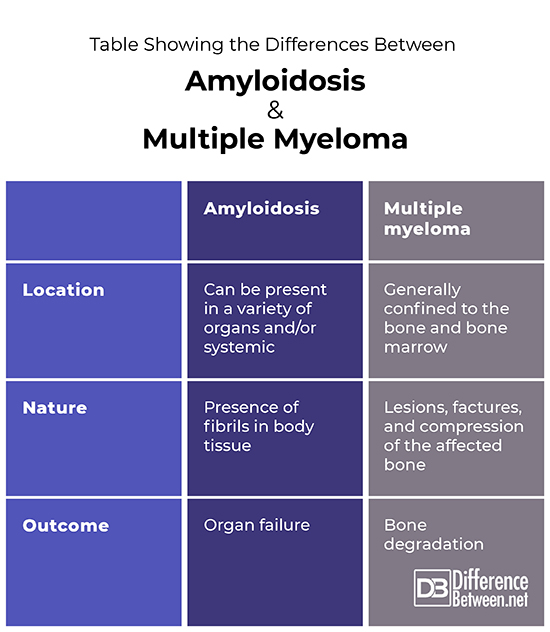Difference Between Amyloidosis and Multiple Myeloma
Multiple myeloma is a blood cancer characterized by the uncontrolled proliferation of plasma cells in the bone marrow. While differentiating between multiple myeloma and amyloidosis is challenging (N.J. Bahlis and Lazarus) because in 12‒15% of cases, the two disorders are associated (Cancer.net), amyloidosis is not considered a cancer.

Causes and Types
Both myeloma and amyloidosis arise when healthy plasma cells change and grow in an out-of-control fashion. Multiple myeloma is located either in the bone, called solitary plasmacytoma, or on the bone, called extramedullary plasmacytoma. In contrast, the protein buildup in amyloidosis occurs in a variety of tissues and organs and the misshapen proteins, called amyloid protein deposits or fibrils, build up in organs and tissues causing symptoms and organ failure. Commonly, the condition may be systemic, meaning amyloid protein deposits are found throughout the body.
Several more common types of amyloidosis have been identified. AL, meaning amyloid and light chain, is the most common and characterized by plasma cells that produce immunoglobulins or antibodies proliferating and becoming misshapen. AA is a secondary autoimmune and inflammatory condition most often associated with other chronic diseases such as tuberculosis, diabetes, rheumatoid arthritis, and inflammatory bowel disease. Hereditary amyloidosis is even rarer and characterized by heart problems, carpal tunnel syndrome and eye abnormalities.

Signs and Symptoms
The signs and symptoms of amyloidosis depend on the organ or function compromised by the protein buildup, for example, an enlarged liver or heart if those organs are affected, and goiter, or the noncancerous swelling of the thyroid gland, if the thyroid gland is affected. In general, signs include swollen legs and ankles, numbness and pain in the extremities, a rash or purplish patches around the eyes, an enlarged tongue, difficulties swallowing, an irregular heartbeat, fatigue and shortness of breath when lying down, and diarrhea and constipation (Mayo Clinic, Amyloidosis).
The signs and symptoms of multiple myeloma include bone pain due to lesions, degradation and shrinking of bone, compression factures of the spine, weakness and numbness in the legs, excessive thirst, nausea, constipation, loss of appetite, mental confusion, fatigue, weight loss, and anemia, as well as frequent infections due to a compromised immune system (Mayo Clinic, Multiple Myeloma). Elevated calcium and creatinine levels have been noted in blood tests (Cancer.net).
Diagnosis
Besides attending to the symptoms, the risk factors associated with age and medical condition, and the results of prior medical tests, diagnosis for both amyloidosis and multiple myeloma is achieved by taking a sample of tissue, called a biopsy, and testing for the presence of amyloid proteins. X-rays, magnetic resonance imagery, and computed tomography are also used to identify bone marrow in which plasma cells have overwhelmed healthy blood cells, or in the case of amyloidosis, fibrils have compromised organ functions.
Treatment
Both conditions require treatment by a multidisciplinary team that administers medications such as chemotherapy to destroy the abnormal cells. Targeted therapies such as immunomodulator drugs and monoclonal antibody and proteasome inhibitors may also be used. Treatment may include controlling the underlying disease and organ transplants in the case of amyloidosis and bone marrow or stem cell transplantation in the case of myeloma.
Table showing the differences between amyloidosis and multiple myeloma

Summary
Amyloidosis and multiple myeloma are two distinct conditions, although the presence of amyloidosis in those suffering multiple myeloma may complicate the course of multiple myeloma and worsen the prognosis (D. Alameda et al.) While both conditions result from proliferating plasma cells, amyloidosis can affect any organ or tissue in the body while multiple myeloma is located in or on the bones and is considered a cancer.
FAQ
Can amyloidosis be mistaken for multiple myeloma?
AL may easily be mistaken for multiple myeloma because both conditions involve the proliferation of plasma-cell proteins, the production of monoclonal immunoglobulins, and have signs and symptoms in common. For example, both conditions are characterized by the presence of fatigue, weakness, pain, and numbness of the extremities. What differentiates amyloidosis from multiple myeloma is that in amyloidosis, the amyloid monoclonal light chains form insoluble fibrils. In contrast, multiple myeloma is associated with the deterioration of the bone and bone marrow.
Is amyloidosis worse than multiple myeloma?
Amyloidosis would seem to be worse. The condition can prove fatal due to organ failure, and treating it is more challenging due to the underlying organ damage (NJ Bahlis and Lazarus). Organ dysfunction is reversible, however, because amyloid deposits have been shown to regress when the supply of the fibril precursor is eradicated. The presence of amyloidosis also worsens the prognosis for those already suffering from multiple myeloma.
Does myeloma cause amyloidosis?
While 12‒15% of patients suffering from multiple myeloma may also suffer from amyloidosis, multiple myeloma does not cause amyloidosis, nor does amyloidosis cause multiple myeloma. They are two separate conditions with amyloidosis complicating the course of multiple myeloma.
Why is amyloidosis not multiple myeloma?
While in both AL and multiple myeloma clonal plasma cells proliferate, the behavior of these cells differs for each condition, leading to different clinical consequences. In AL clonal plasma cells create amyloid fibrils. In multiple myeloma, clonal plasma cells cause lesions and fractures of the bone. D. Alameda et al note a further three important differences: First, plasma cells from patients with AL look like secondary lymphoid organ plasma cells, whereas multiple myeloma cells look like peripheral blood and newborn bone marrow plasma cells. Second, in multiple myeloma, symptoms arising from the overall burden of the disease is debilitating while in amyloidosis the tumor burden is lower and thus fewer symptoms are apparent. Third, monoclonal protein rarely causes issues in multiple myeloma, while in amyloidosis, uncomfortable symptoms arise from protein buildup or fibrils.
- Difference Between Ecchymosis and Erythema - August 15, 2022
- Difference Between Autobiographical Memory and Episodic Memory - August 1, 2022
- Difference Between Biological Drive and Social Motive - July 30, 2022
Search DifferenceBetween.net :
Leave a Response
References :
[0]Alameda, D. et al. Tumor cells in light-chain amyloidosis and myeloma show different transcriptional rewiring of the normal plasma cell development. Blood, 138 (17): 1583‒1589, 2021
[1]Bahlis, N.J. and Lazarus, H.M. Mutliple myeloma-associated AL amyloidsosis: is a distinctive therapeutic approach warranted? Bone Marrow Transplantation, 38, 7‒15, 2006.
[2]Cancer.net. Types of Cancer, n.d. https://www.cancer.net/cancer-types
[3]Mayo Clinic. Amyloidosis, n.d., https://www.mayoclinic.org/diseases-conditions/amyloidosis/symptoms-causes/syc-20353178
[4]Mayo Clinic. Multiple myeloma, n.d. https://www.mayoclinic.org/diseases-conditions/multiple-myeloma/symptoms-causes/syc-20353378
